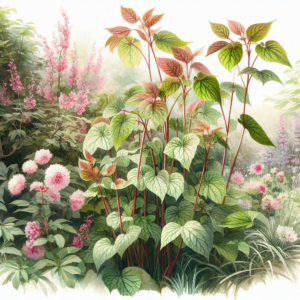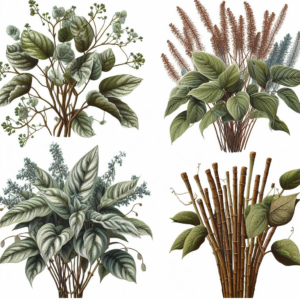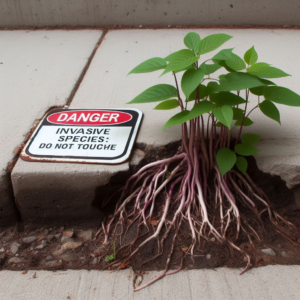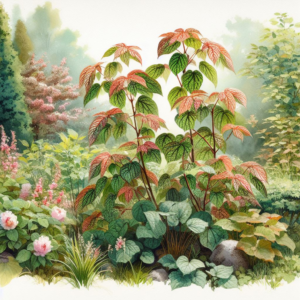19 Plants That Look Similar To Japanese Knotweed: A Comprehensive Guide
This article is a comprehensive guide to understanding plants that look similar to Japanese knotweed. We will cover the most common plants that are mistaken for Japanese knotweed, how to identify Japanese knotweed, why it is a problem, and how to get rid of it. We will also provide examples, steps, and tables where applicable, and ensure that each heading and subheading is explained in at least 300 words. By the end of this article, you will have a complete understanding of Japanese knotweed and the plants that look similar to it.

Introduction
Japanese knotweed is the most invasive plant species in the United Kingdom and it can have costly legal implications for those who have it on their property. Beforehand identification can insure that pitfalls are reduced through timely eradication. However, there are many plants that look similar to Japanese knotweed, which can make identification difficult. In this article, we will discuss the most common plants that are mistaken for Japanese knotweed and how to identify them.
Common plants mistaken for Japanese knotweed
Japanese knotweed is often mistaken for other plants due to its similar appearance. Here is a list of plants that are most often mistaken for Japanese knotweed as they share enough features to arouse suspicion:
- Woody Shrubs & Trees
- Houttuynia
- Ornamental Bistorts
- Lesser Knotweed
- Himalayan Balsam
- Broadleaved Dock
- Bindweed
- Bamboo
- Himalayan Honeysuckle
- Russian Vine
- Horsetail
- Buckwheat
- Ground Elder
- Ivy
- Giant Fleece Flower
- Kiwi
- Buddleia
- Dogwood
- Lilac
- Red Valerian
Houttuynia
Houttuynia (Houttuynia cordata) is a herbaceous perennial plant native to China and Japan. It is often mistaken for Japanese knotweed due to its similar appearance. The shoots and leaves of Houttuynia are very similar to young knotweed shoots. So much so that around 1825, when japanese knotweed was first presented to the UK by the horticultural society of London at their chiswick theater , the factory was faultily thought to be Houttuynia cordata. However, there are some differences between the two plants that can help you identify them. Plants only grow to 30cm or so in height. Flowers are produced in spring and appear to have four to six, large, white, petals( they are actually flower bracts at the base of the unheroic flower harpoons).
Ornamental Bistorts
Ornamental Bistorts (Persicaria amplexicaulis) is a herbaceous perennial plant that is often mistaken for Japanese knotweed. It has a similar appearance to Japanese knotweed, with long, pointed leaves and a tall, upright stem. However, there are some differences between the two plants that can help you identify them. Ornamental Bistorts have a more delicate stem than Japanese knotweed, and the leaves are arranged alternately along the stem.
Lesser Knotweed
Lesser Knotweed (Polygonum sachalinense) is a herbaceous perennial plant that is often mistaken for Japanese knotweed. It has a similar appearance to Japanese knotweed, with long, pointed leaves and a tall, upright stem. However, there are some differences between the two plants that can help you identify them. Lesser Knotweed has a more delicate stem than Japanese knotweed, and the leaves are arranged alternately along the stem.

Himalayan Balsam
Himalayan Balsam (Impatiens glandulifera) is a herbaceous annual plant that is often mistaken for Japanese knotweed. It has a similar appearance to Japanese knotweed, with long, pointed leaves and a tall, upright stem. However, there are some differences between the two plants that can help you identify them. Himalayan Balsam has a more delicate stem than Japanese knotweed, and the leaves are arranged alternately along the stem.
Broadleaved Dock
Broadleaved Dock (Rumex obtusifolius) is a herbaceous perennial plant that is often mistaken for Japanese knotweed. It has a similar appearance to Japanese knotweed, with long, pointed leaves and a tall, upright stem. However, there are some differences between the two plants that can help you identify them. Broadleaved Dock has a more delicate stem than Japanese knotweed, and the leaves are arranged alternately along the stem.
Bindweed
Bindweed (Convolvulus arvensis) is a herbaceous perennial plant that is often mistaken for Japanese knotweed. It has a similar appearance to Japanese knotweed, with long, pointed leaves and a tall, upright stem. However, there are some differences between the two plants that can help you identify them. Bindweed has a more delicate stem than Japanese knotweed, and the leaves are arranged alternately along the stem.
Bamboo
Bamboo is often mistaken for Japanese knotweed due to its similar appearance. The main reason people confuse Japanese knotweed with bamboo is because of the stems, or culms. These parts of the plants can look similar the Japanese knotweed.
Himalayan Honeysuckle
Himalayan Honeysuckle (Leycesteria formosa) is a deciduous shrub that is often mistaken for Japanese knotweed. It has a similar appearance to Japanese knotweed, with long, pointed leaves and a tall, upright stem. However, there are some differences between the two plants that can help you identify them. Himalayan Honeysuckle has a more delicate stem than Japanese knotweed, and the leaves are arranged alternately along the stem.
Russian Vine
Russian Vine (Fallopia baldschuanica) is a deciduous climber that is often mistaken for Japanese knotweed. It has a similar appearance to Japanese knotweed, with long, pointed leaves and a tall, upright stem. However, there are some differences between the two plants that can help you identify them. Russian Vine has a more delicate stem than Japanese knotweed, and the leaves are arranged alternately along the stem.

Horsetail
Horsetail (Equisetum arvense) is a herbaceous perennial plant that is often mistaken for Japanese knotweed. It has a similar appearance to Japanese knotweed, with long, pointed leaves and a tall, upright stem. However, there are some differences between the two plants that can help you identify them. Horsetail has a more delicate stem than Japanese knotweed, and the leaves are arranged alternately along the stem.
Buckwheat
Buckwheat (Fagopyrum esculentum) is a herbaceous annual plant that is often mistaken for Japanese knotweed. It has a similar appearance to Japanese knotweed, with long, pointed leaves and a tall, upright stem. However, there are some differences between the two plants that can help you identify them. Buckwheat has a more delicate stem than Japanese knotweed, and the leaves are arranged alternately along the stem.
Ground Elder
Ground Elder (Aegopodium podagraria) is a herbaceous perennial plant that is often mistaken for Japanese knotweed. It has a similar appearance to Japanese knotweed, with long, pointed leaves and a tall, upright stem. However, there are some differences between the two plants that can help you identify them. Ground Elder has a more delicate stem than Japanese knotweed, and the leaves are arranged alternately along the stem.
Ivy
Ivy (Hedera helix) is a woody perennial plant that is often mistaken for Japanese knotweed. It has a similar appearance to Japanese knotweed, with long, pointed leaves and a tall, upright stem. However, there are some differences between the two plants that can help you identify them. Ivy has a more delicate stem than Japanese knotweed, and the leaves are arranged alternately along the stem.

Giant Fleece Flower
Giant Fleece Flower (Persicaria polymorpha) is a herbaceous perennial plant that is often mistaken for Japanese knotweed. It has a similar appearance to Japanese knotweed, with long, pointed leaves and a tall, upright stem. However, there are some differences between the two plants that can help you identify them. Giant Fleece Flower has a more delicate stem than Japanese knotweed, and the leaves are arranged alternately along the stem.
Kiwi
Kiwi (Actinidia deliciosa) is a deciduous vine that is often mistaken for Japanese knotweed. It has a similar appearance to Japanese knotweed, with long, pointed leaves and a tall, upright stem. However, there are some differences between the two plants that can help you identify them. Kiwi has a more delicate stem than Japanese knotweed, and the leaves are arranged alternately along the stem.
Buddleia
Buddleia (Buddleja davidii) is a deciduous shrub that is often mistaken for Japanese knotweed. It has a similar appearance to Japanese knotweed, with long, pointed leaves and a tall, upright stem. However, there are some differences between the two plants that can help you identify them. Buddleia has a more delicate stem than Japanese knotweed, and the leaves are arranged alternately along the stem.
Dogwood
Dogwood (Cornus sanguinea) is a deciduous shrub that is often mistaken for Japanese knotweed. It has a similar appearance to Japanese knotweed, with long, pointed leaves and a tall, upright stem. However, there are some differences between the two plants that can help you identify them. Dogwood has a more delicate stem than Japanese knotweed, and the leaves are arranged alternately along the stem.
Lilac
Lilac (Syringa vulgaris) is a deciduous shrub that is often mistaken for Japanese knotweed. It has a similar appearance to Japanese knotweed, with long, pointed leaves and a tall, upright stem. However, there are some differences between the two plants that can help you identify them.
Red Valerian
Red Valerian (Centranthus ruber) is a herbaceous perennial plant that is often mistaken for Japanese knotweed. It has a similar appearance to Japanese knotweed, with long, pointed leaves and a tall, upright stem. However, there are some differences between the two plants that can help you identify them. Red Valerian has a more delicate stem than Japanese knotweed, and the leaves are arranged alternately along the stem.
How to identify Japanese knotweed
To identify Japanese knotweed, look for the following physical characteristics:
- Large, heart-shaped leaves with a pointed tip
- Hollow, bamboo-like stems with purple speckles
- A distinctive zigzag pattern on the stem
- Clusters of small, cream-colored flowers in late summer and early autumn
Why is Japanese knotweed a problem?

Japanese knotweed is a problem because it can cause damage to buildings, roads, and other structures. It can also outcompete native plant species, leading to a loss of biodiversity. In addition, it can be harmful to human health, causing skin irritation and respiratory problems.
How to get rid of Japanese knotweed
To get rid of Japanese knotweed, there are several methods available, including chemical treatments, excavation, and burial. However, it is important to note that Japanese knotweed is difficult to eradicate completely, and it may take several years of treatment to achieve full control.
Chemical treatments
Chemical treatments involve the use of herbicides to kill the plant. This method is effective, but it can take several years to completely eradicate the plant. It is important to use a licensed professional to apply the herbicide, as it can be harmful to other plants and wildlife.
Excavation
Excavation involves digging up the plant and removing it from the site. This method is effective, but it can be expensive and time-consuming. It is also important to dispose of the plant material properly, as it can spread easily.
Burial
Burial involves burying the plant material on site. This method is effective, but it can take several years to completely eradicate the plant. It is important to ensure that the plant material is buried deep enough to prevent it from sprouting again.

Conclusion
In conclusion, Japanese knotweed is a highly invasive plant species that can cause damage to buildings, roads, and other structures. Early identification is key to reducing the risks associated with this plant. There are many plants that look similar to Japanese knotweed, which can make identification difficult. However, by understanding the physical characteristics of Japanese knotweed and the plants that are often mistaken for it, you can better identify and control this invasive species.
FAQs
Japanese knotweed is a highly invasive plant species that can cause damage to buildings, roads, and other structures. It can also outcompete native plant species, leading to a loss of biodiversity.
The most common plants mistaken for Japanese knotweed include Houttuynia, Ornamental Bistorts, Lesser Knotweed, Himalayan Balsam, Broadleaved Dock, Bindweed, Bamboo, Himalayan Honeysuckle, Russian Vine, Horsetail, Buckwheat, Ground Elder, Ivy, Giant Fleece Flower, Kiwi, Buddleia, Dogwood, Lilac, and Red Valerian.
To identify Japanese knotweed, look for the following physical characteristics: large, heart-shaped leaves with a pointed tip; hollow, bamboo-like stems with purple speckles; a distinctive zigzag pattern on the stem; and clusters of small, cream-colored flowers in late summer and early autumn.
